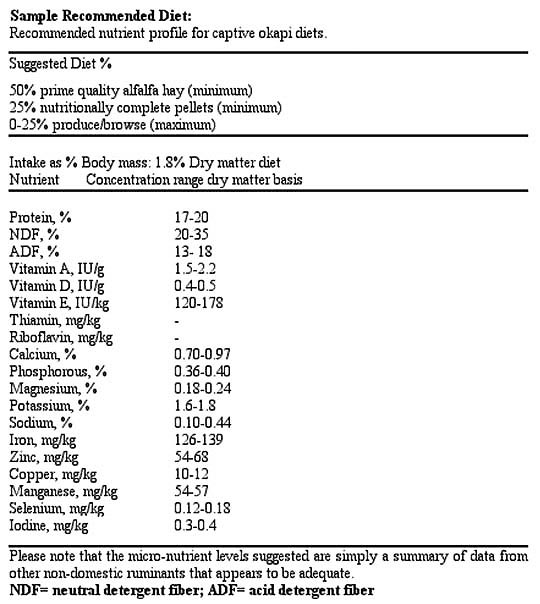Nutrition
Okapis are ruminant browsers
The okapi is as selective browser
Amount and type of feed
Food Schedules and Presentation
Okapis are ruminant browsers. As such, they require high quality
alfalfa hay and other food items, which are highly digestible and
when combined, offer a nutritionally complete diet based on what
we know about okapis and other ruminant, browsing species.
Given this species’ special adaptations for procuring and digesting
food, manipulation of browse and rumination are important considerations
in selecting the physical form of food items offered.
This highlights the importance of offering forage items that can
be manipulated by the tongue, and long fiber fractions, from hay
and browse conducive to proper rumination.
Top
The okapi is a selective browser with a preference for high quality
tender foliage in the wild. (Hart and Hart, 1988) The consumption
of plant fruit has not been reported. Comprehensive
data on the total diet is lacking and little is known about the
actual nutrient composition of the total diet consumed in nature.
With respect to the various food groups offered, the diet should
consist of at least 25% pelleted diet and at least 50% alfalfa and
browse. Zero to no more than 25%, by weight, of the total diet
intake should consist of produce. It is important for the hay to
be analyzed on a regular basis to verify levels of available protein,
fat, vitamins and minerals. Specifications of the pelleted diet
should complement the usual results of the hay to provide a balanced
diet for this species. Browse can be an important component
of the diet and can replace some of the forage component if
chemical composition is known and appropriate quantities are
consumed. Salt blocks, which also complement the rest of the
diet as offered, should be provided on a regular basis. Young individuals
sometimes become obsessive lickers of salt, so access may
need to be limited and monitored in these situations. Water
should be provided ad lib under normal circumstances.
Top
Amount and Type of Feed: Okapis should consume at least
1.8% of their body weight (in DM) daily. This means they must
be offered more than this, from 2–2.4% of body weight.
Depending on the quality of the hay, they may need more or less.
If hay quality is poor with respect to either nutrients or digestibility,
more food must be consumed. However, since there is a limit
to gut capacity, a high quality diet is important for this species.
Water bowls and food containers should be placed in several
areas throughout the space, located away from high-traffic areas to
minimize the possibility of animals accidentally running into
them or fouling them. Their design should be smooth and
rounded to minimize animal injury. Their design should also
minimize the risk of animal entanglement. These containers
should be raised off the floor to a height of ~30 inches (76 cm.).
As browsers, they rarely eat from the forest floor, as this is physically
difficult for them. This height gives animals of all ages easy
access to contents, including young calves, which need to reach to
investigate and sample the diet. Additional hay and browse can
also be placed higher than 30” to accommodate adult animals.
Automatic drinkers are commonly used. Drinkers should be serviced
daily to maintain sanitary conditions and freshness. Both
water and food containers should be scrubbed on a regular basis
to maintain sanitary conditions.
Top
Food Schedules and Presentation: Forage and water should be
present at all times unless otherwise directed by the veterinary
staff. High-quality alfalfa hay should be renewed at least twice a
day. The pelleted portion of the diet, along with any produce,
can be split into a number of smaller portions and fed throughout
the day as decided upon in the daily routine. Feeding various
parts of the diet in novel locations or in dispensers which make
the animals work to obtain the food will lengthen the feeding
time for the animal and may promote natural behaviors. Offering
browse when available also provides an opportunity for the animals
to strip leaves and tender bark from the branches.
Body condition can be assessed as in other ungulates.
Prominence of bony joints (hips, pelvis) or noticeable vertebrae,
sunken flanks, noticeable ribs or bony heads, and poor coat condition
are signs of declining condition. Acquiring regular weights
helps assimilate seasonal or life-function weight variations.
Additional food quantities may be needed to maintain good
condition in growing, lactating and active animals. Young animals
grow fast. Lactation is known to be a serious drain on most
females. Acquiring weights on a regular basis in addition to visual
inspection provides animal care staff with the information they
need to assess individual situations and respond accordingly.
| |
 |
Top
HUSBANDRY GUIDELINES
FOR THE OKAPI SSP - Sept 2004
Edited by Terry DeRosa, San Antonio Zoo,
Fran Lyon, White Oak Conservation Center and
Ann Petric, Okapi SSP Coordinator, Brookfield Zoo
Illustration: J. Busch
Updated and adapted for the web, Patrick Immens